Outforia Quicktake: Key Takeaways
- Jellyfish are opportunistic carnivores, eating copepods, fish larvae, fish eggs, phytoplankton, and planktonic eggs.
- Larger jellyfish may feed on crabs, shrimp, and fish.
- Jellyfish catch prey with their “oral arms” containing nematocysts which stun prey.
- They have a simple digestive system that consists of a coelenteron or “blind gut”.
- Predators of jellyfish include large fish, sea turtles, some crabs, and seabirds.
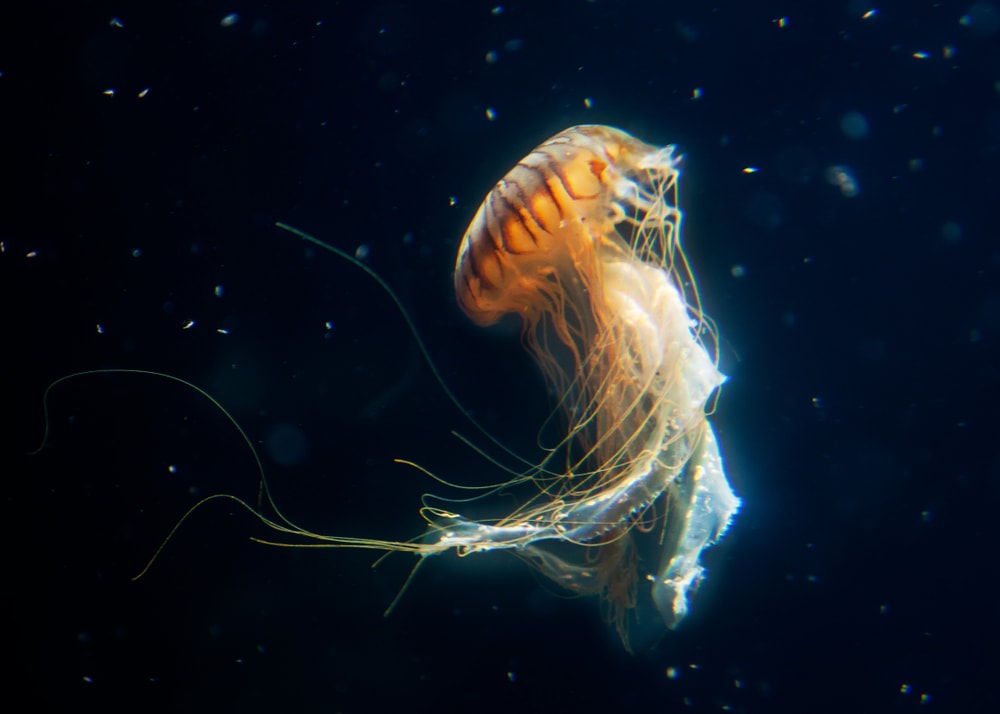
With no blood, heart, or brain, jellyfish are one of the simplest animals on the planet. In fact, most of a jellyfish’s body consists of water.
Despite this, their digestive system is quite complex. It’s like that of more complex animals. Still, jellyfish eat and poop out of the same hole. Gross, right?
But, what do jellyfish eat? It depends how big they are and what stage of life they’re in. But generally, jellyfish will eat just about any animal that is smaller than them.
What Is a Jellyfish?
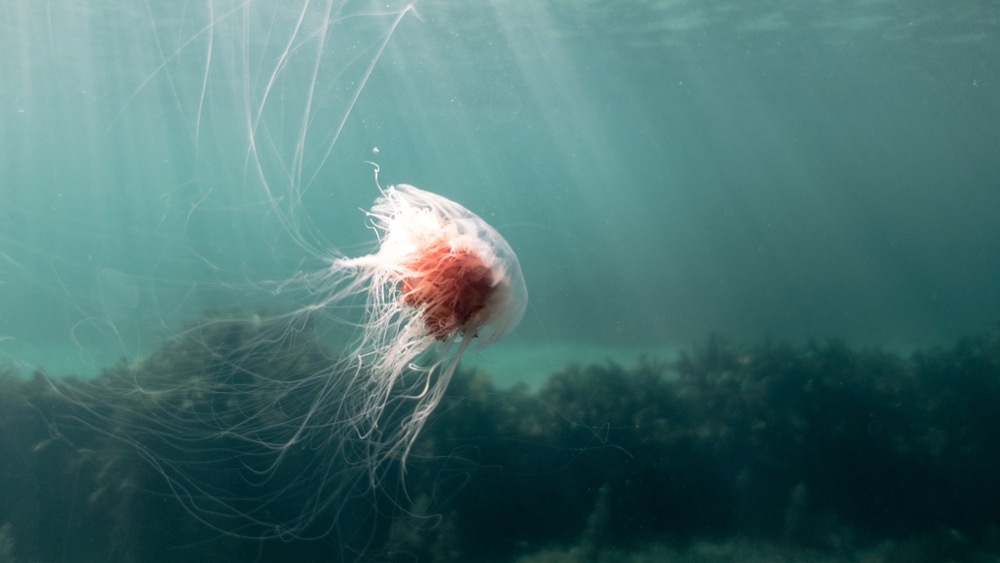
Jellyfish are a planktonic invertebrate of the phylum cnidaria. There are over 200 species in the class Scyphozoa, and about 20 species in the class cubozoa. The scyphozoan jellyfish consists of two groups: free-swimming medusae and sessile. Those that are sessile attach themselves to an object with a stalk.
Planktonic
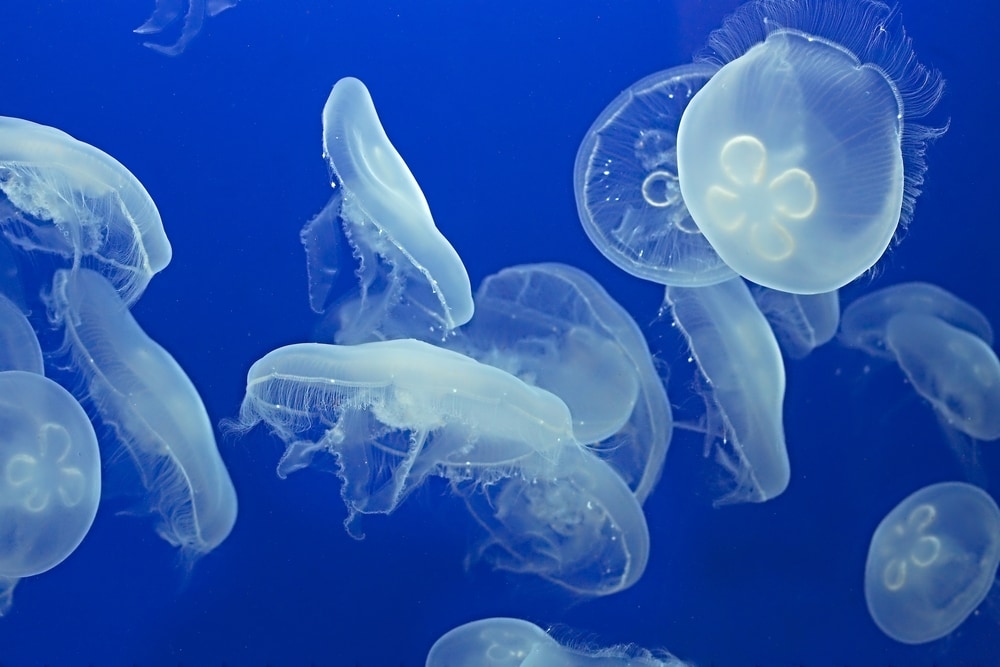
Being planktonic means that they free float around the ocean. Jellyfish are able to swim to some extent, but they are very weak swimmers. They cannot swim against most currents, so mostly, they go with the flow. To swim, they will propel themselves forward by contracting their bells.
Jellyfish that are free-swimming live in all the world’s oceans. They are often found near the shoreline.
Their Bodies
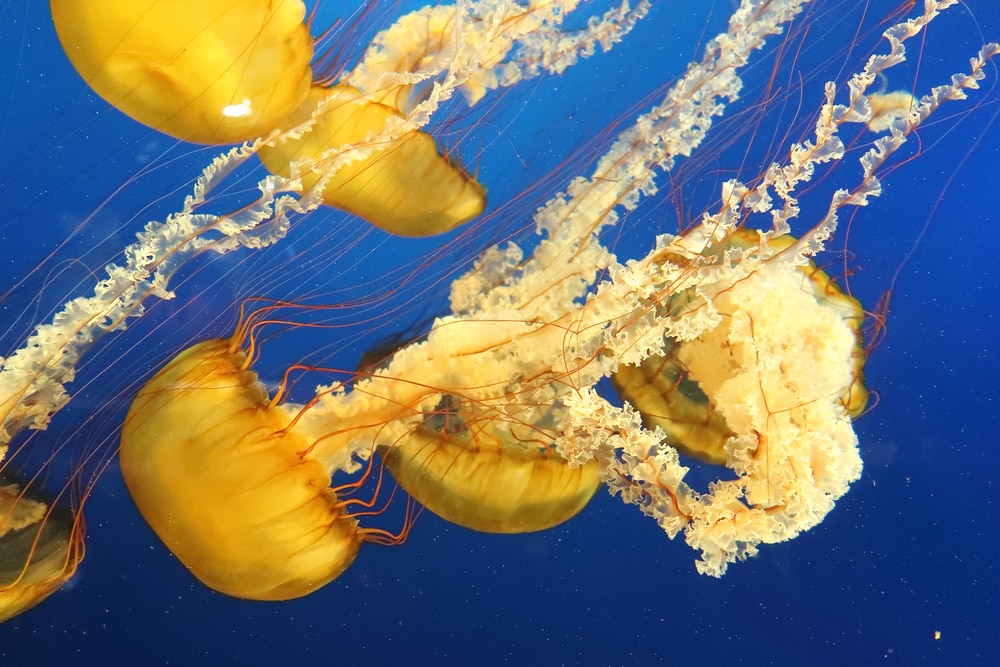
They have disk-shaped bodies that usually range in size from 1-16in (2-40cm) in diameter. Some species grow much larger, up to 6.6ft (2m) in diameter.
Their bodies consist of about 99% water, and their bodies consist of two layers. The two layers are the ectoderm and the endoderm. Between these two layers lies mesoglea. This is the gelatinous material that gives jellyfish their name. In most species, the mesolglea is transparent and thick.
Jellyfish do not have any bones, a brain, or a heart.
They Can Sting
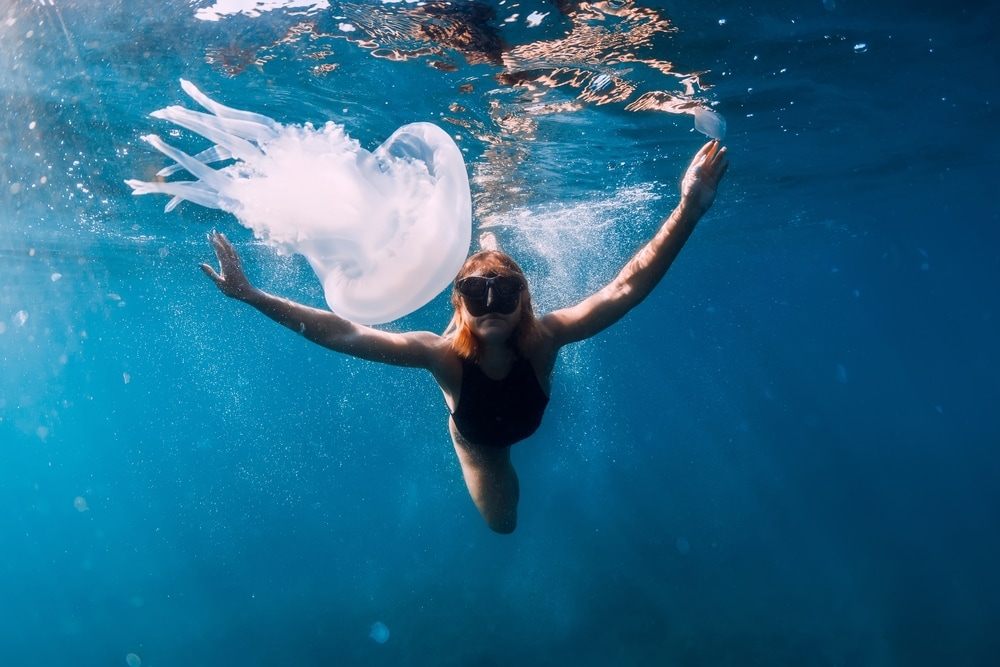
Being part of the phylum cnidaria means that jellyfish can sting. Jellyfish and other cnidarians have cells called cnidocytes that burst when touched. Each of these cells contains a nematocyst which is a stinging cell. The nematocyst enters the skin like a barb and releases a harmful toxin.
Jellyfish species use nematocysts to stun and capture prey. These stings are very painful, but they are rarely lethal or even overly harmful to humans.
As with most things, there are exceptions. The most dangerous and lethal jellyfish is the box jellyfish. They live in the Indo-Pacific Ocean and off the coast of northern Australia.
When a nematocyst enters the skin, it can cause a spike in blood pressure if it enters the blood stream. Toxins from box jellyfish are strong enough that they can stop the heart.
What Is A Jellyfish’s Life Cycle?
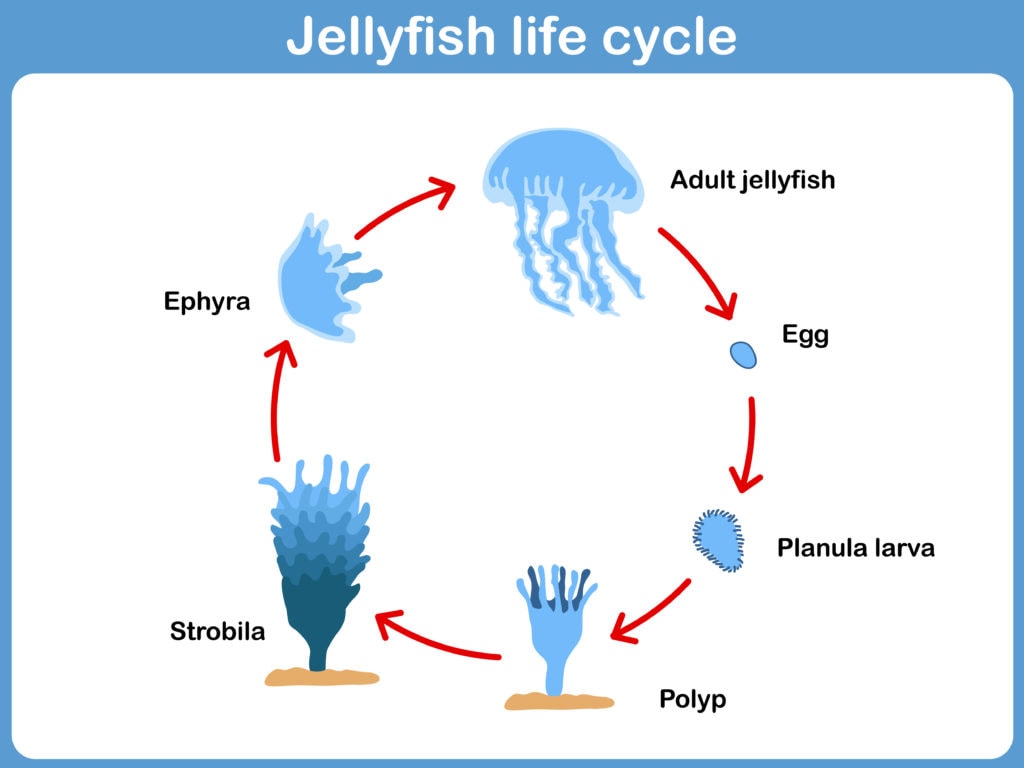
A jellyfish’s life cycle consists of four parts: the larva stage, sedentary polyp, ephyrae, and adult “medusa” stage.
As a larva, the jellyfish has just come from the egg and sperm of its parents. They will free-float until they find a solid surface to land on where they can begin developing. Once they find a good spot, they become a sedentrary polyp.
The polyp stage is the longest stage of a jellyfish’s life. Most species remain in the polyp stage for a few years. During this time, the jellyfish will develop their digestive system.
After that stage, the jellyfish will become an ephyra. An ephyra is a larval jellyfish that looks much like the adult version. They will continue growing until they reach the adult “medusa” stage.
How Long Do Jellyfish Live?

How long a jellyfish lives depends on its species. Some jellyfish only live for a few days, while others can live up to 20 years.
But, researchers have found that one species of jellyfish is all but immortal. The Immortal Jellyfish, Turritopsis dohrnii, can reprogram its cells. This basically allows it to become younger. These jellyfish will use this ability whenever they become old, sick, or are facing danger.
What Animals Do We Confuse As Jellyfish?
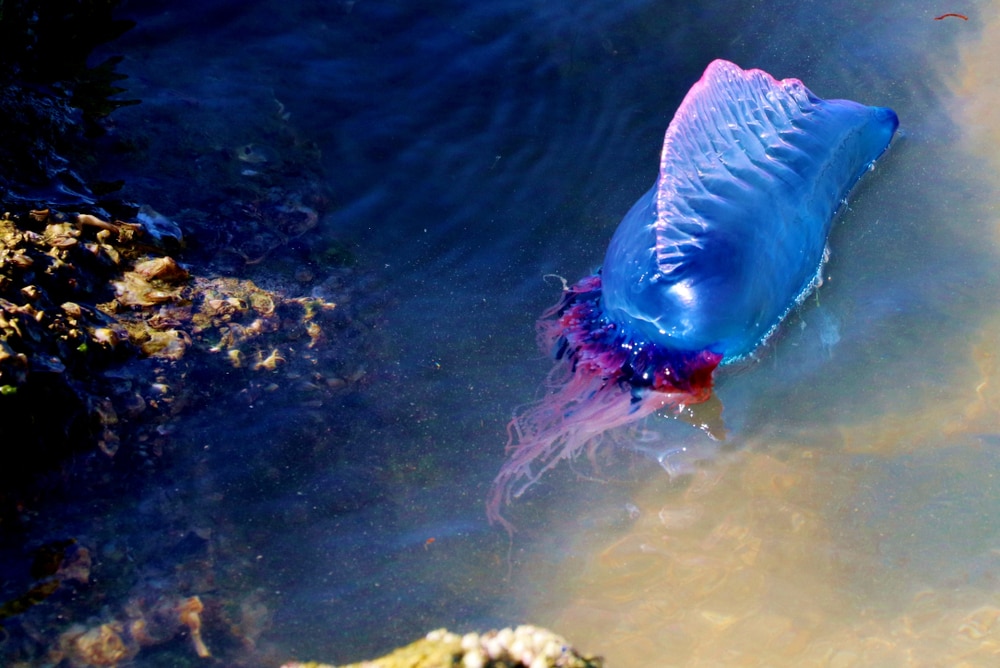
Sometimes, other kinds of animals are mistaken for “jellyfish”. Although they may look similar, they aren’t really jellyfish at all.
One of the most common examples is the Portuguese man-of-war. They look like jellyfish and they sting like jellyfish. But, they aren’t actually jellyfish. They are a type of siphonophore.
The Portuguese man-of-war is not actually a single organism. Instead, it’s made up of a colony of four different polyps.
They cannot propel themselves through the water like jellyfish. So, they are completely at the mercy of the ocean. Also, unlike jellyfish, the Portuguese man-of-war is incredibly harmful to humans. But, it’s rarely lethal.
Some other species commonly confused for jellyfish include hydromedusae, comb jellies, and salps.
You may also like: 15 Different Types Of Jellyfish You Need To Know: Chart And Pictures
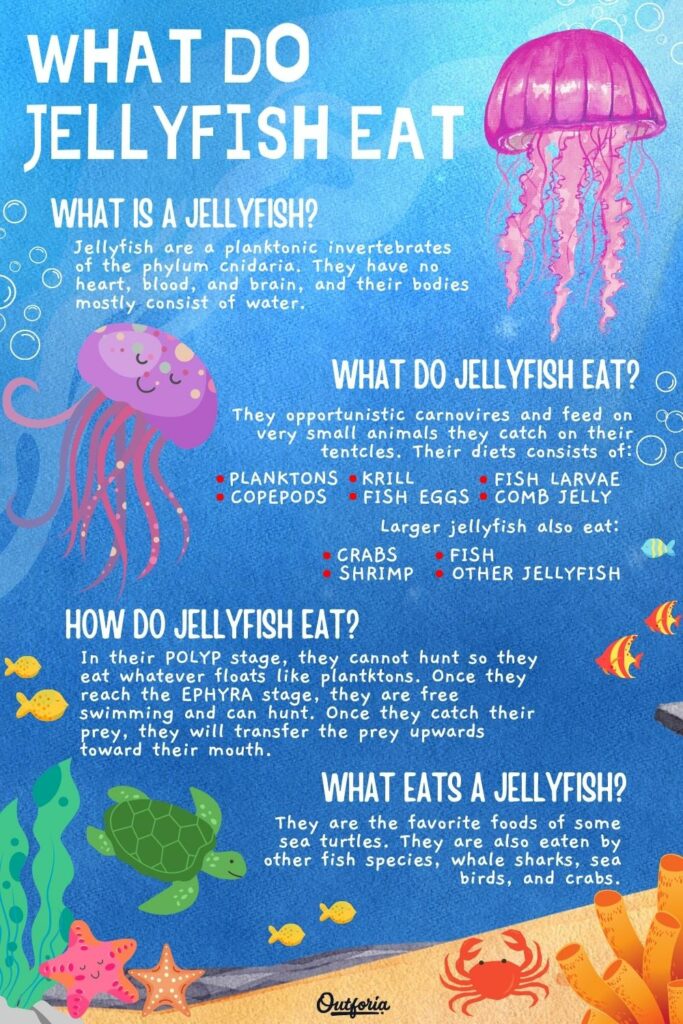
SHARE THIS IMAGE ON YOUR SITE
<a href="https://outforia.com/what-do-jellyfish-eat/"><img style="width:100%;" src="https://outforia.com/wp-content/uploads/2022/12/what-do-jellyfish-eat-infographic-1222-683x1024.jpg"></a><br>what do jellyfish eat <a href="https://outforia.com">Outforia</a>What Do Jellyfish Eat?
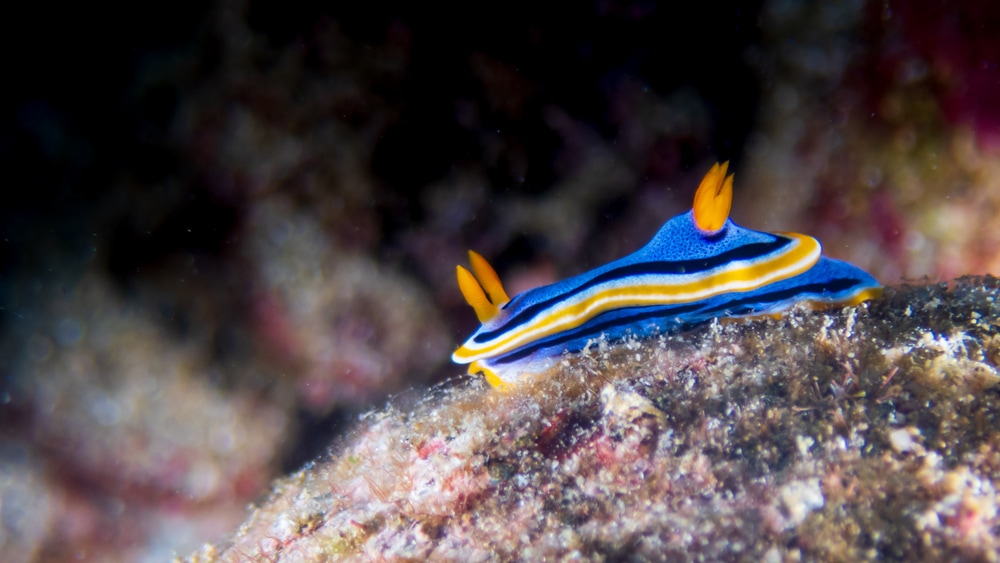
Jellyfish are opportunistic carnivores. They feed on very small animals that they catch within their tentacles. A jellyfish diet generally consists of copepods, fish larvae, fish eggs, phytoplankton, and planktonic eggs. Some jellyfish will even eat other jellyfish.
Larger jellyfish may also feed on crabs, shrimp, and fish.
Curious about what different jellyfish species diets consist of? Take a look at this short list:
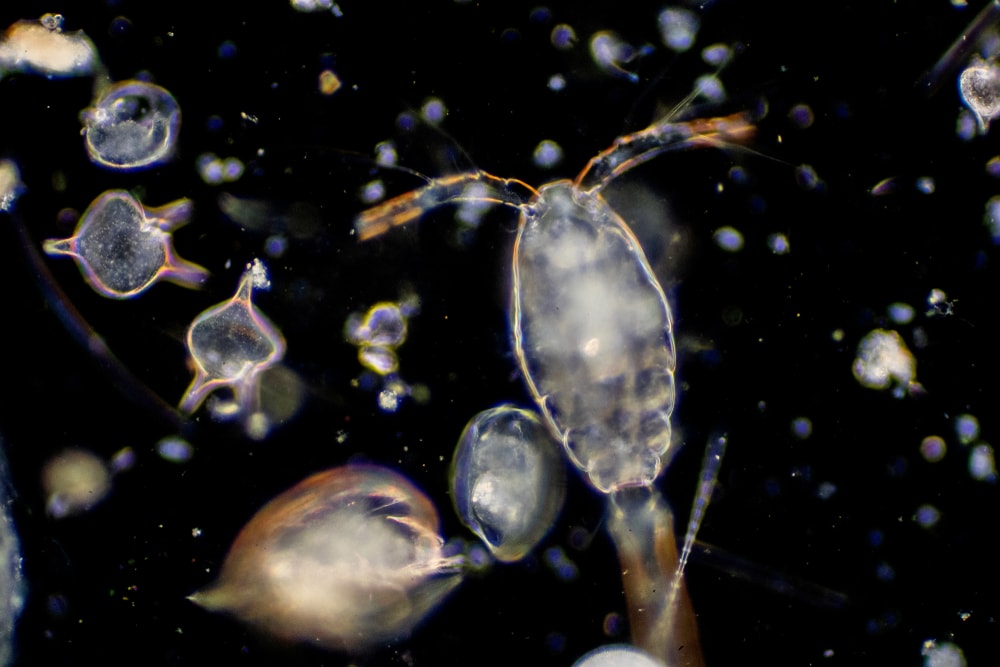

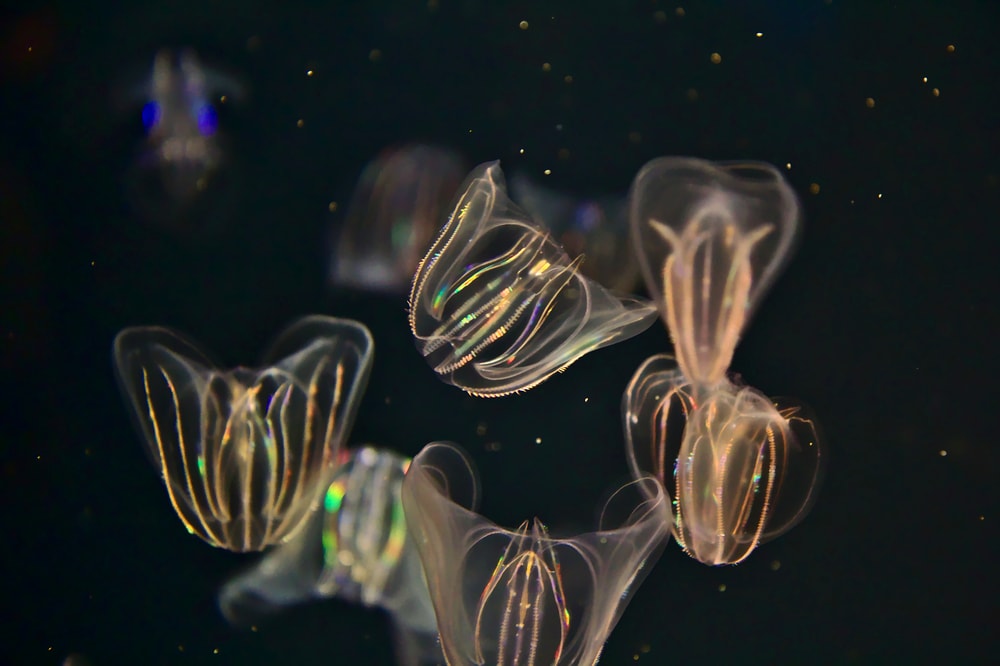
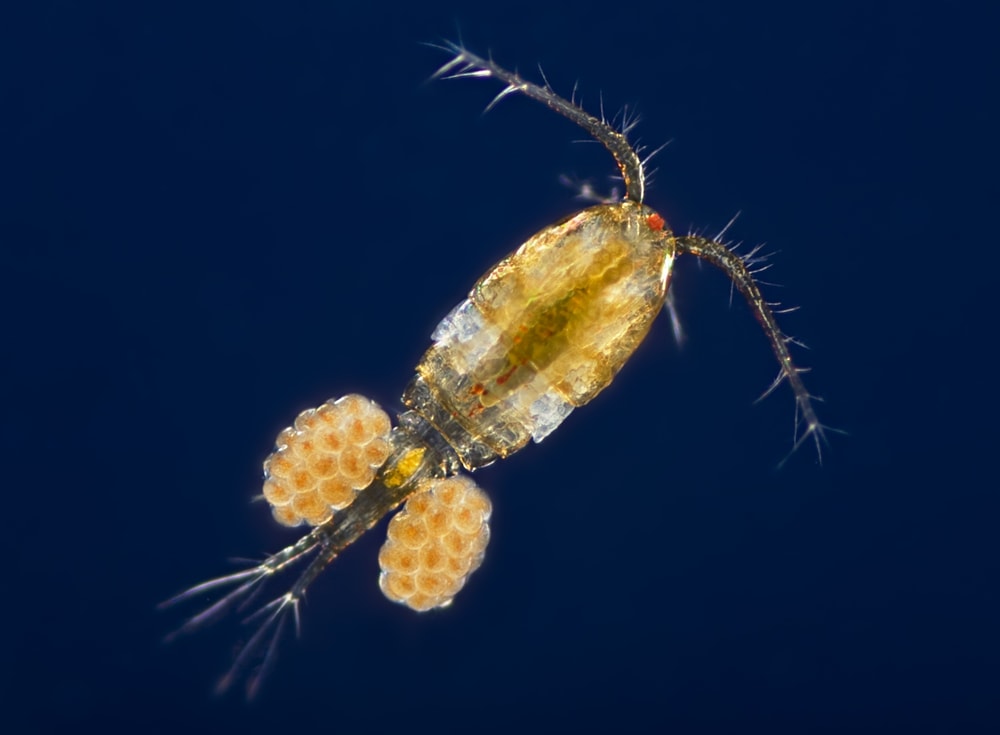
- Crystal Jellyfish: copepods, comb jellies, smaller jellyfish
- Sea Gooseberries: copepods, krill, smaller jellyfish
- Moon Jellyfish: plankton, copepods, mollusks, fish eggs, smaller jellyfish
- Blue Button Jellyfish: plankton, sea slugs, sea snails
- Mushroom Cap Jellyfish: plankton
- Lion’s Mane Jellyfish: fish
- Immortal Jellyfish: plankton, fish eggs, larvae
Spotted Jellyfish
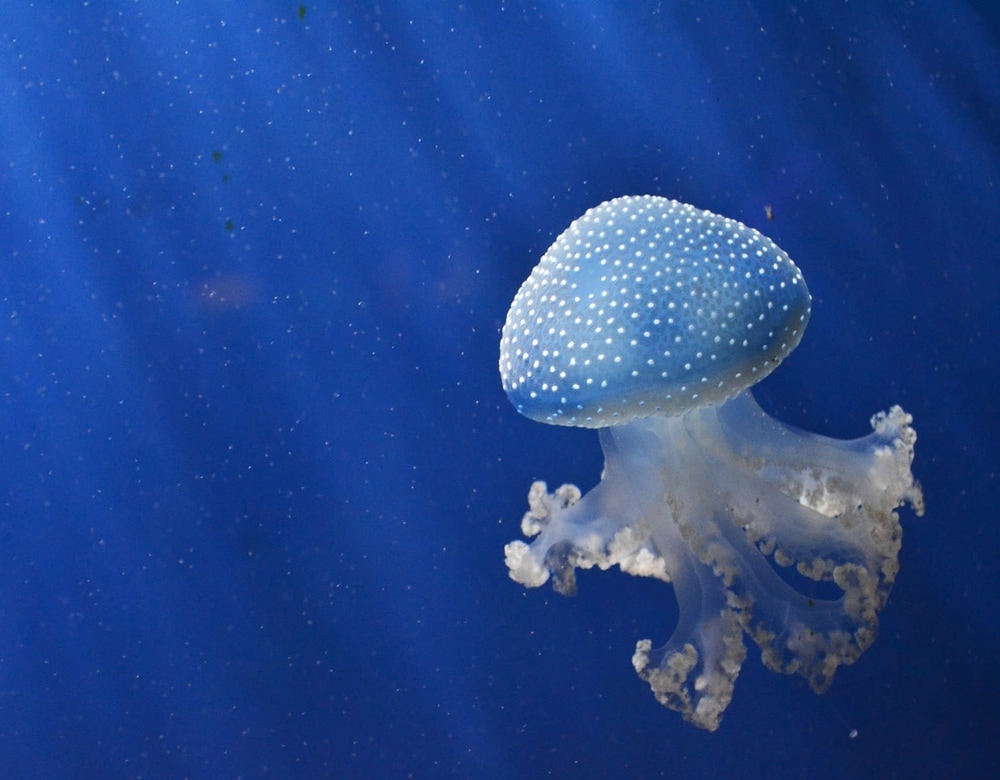
The spotted jellyfish is special in that it grows its own food. It grows algae inside its stomach which they use to photosynthesize. This provides nutrients to the rest of the body.
You may also like: 22 Incredible Types Of Octopus (Names, Photos & Interesting Facts)
How Do Jellyfish Get Their Food?
Often, jellyfish will hunt in “blooms”. A jellyfish bloom is a large group of jellyfish that hunt together. They are voracious eaters, so hunting in blooms can be very successful. These blooms can grow incredibly large, sometimes consisting of over one million jellyfish.
Jellyfish catch prey with their “oral arms”, thicker, tentacle-like appendages near their mouth. These oral arms contain the nematocysts which stun prey.
Because jellyfish are weak swimmers, they will not actively hunt for food. Instead, they flare out their tentacles to catch prey as it swims by.
Rather than hunting, some species merely suspension feed. They filter small zooplankton and phytoplankton from the water.
How Do Jellyfish Eat?
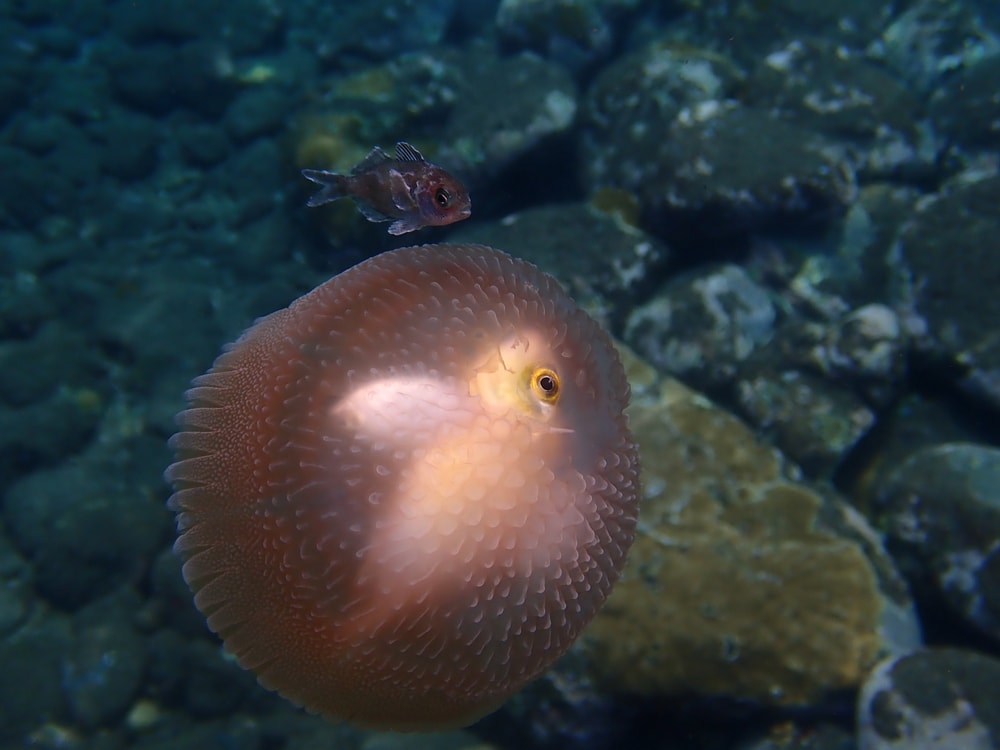
How and what a jellyfish eats depends on what stage of life it’s in. A jellyfish changes drastically as it ages, and so does its food.
During the sedintary polyp stage, jellyfish begin to develop their digestive system. But, they are not free-floating during this stage, so they are unable to hunt. So, they must rely on eating whatever floats by, like zooplankton and phytoplankton.
Once jellyfish reach the ephyra stage, they are free-swiming and can hunt for their prey. They stay free-swimming into their adult stage and will hunt in the same way. The ephyra stage is when they begin eating their larger prey.
How a jellyfish eats is quite similar to that of other animals despite its simple body. Once they catch their prey, they will transfer the prey upwards toward their mouth.
The mouth lives on the underside of the bell at the center of the tentacles. The mouth is a small opening that they use both for eating and expelling waste.
Their digestive system consists of a coelenteron or a “blind gut”. It works similarly to intestines, using enzymes to digest the food.
How Do Jellyfish Poop?
Once the food is digested, the remaining waste is expelled back through the mouth.
You may also like: All 7 Different Types Of Sea Turtles: Pictures, Classification & Facts
Jellyfish Anatomy
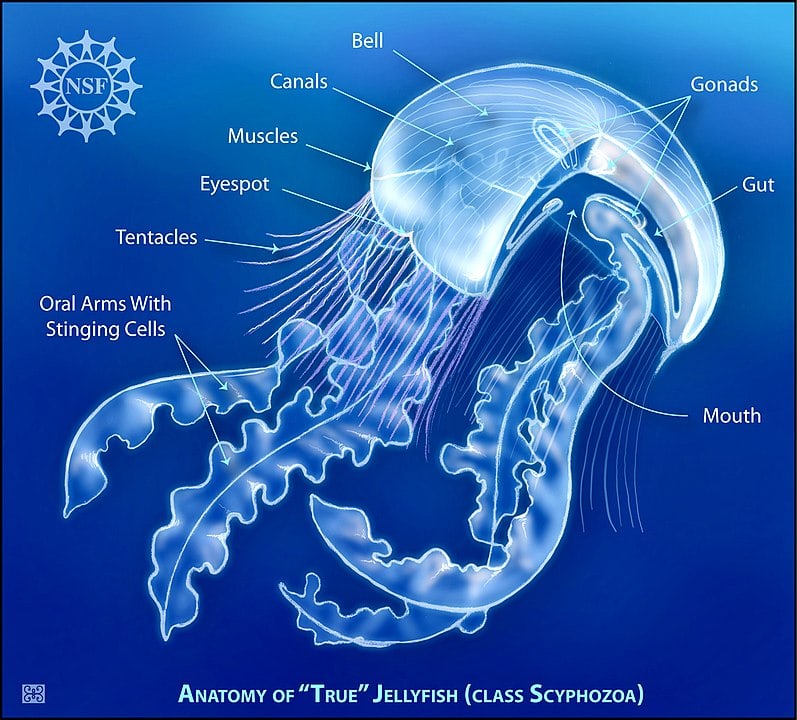
By Zina Deretsky, National Science Foundation – http://www.nsf.gov/news/mmg/mmg_disp.cfm?med_id=65101&from=search_list / Public Domain / Wikimedia commons
All true jellyfish share a few common traits. The first is their umbrella-shaped body otherwise known as a “bell”. They have radial symmetry, which means they are round in shape and the same all around. This round body shape allows them to detect food and danger in all directions.
Most jellyfish have tentacles hanging from the bell that they use for eating. They have a single mouth that also works as an anus. Inside the mouth is a small stomach pouch where the food digests. The vast majority of jellyfish also have nematocysts that they use to paralyze prey.
Among the tentacles, they have thicker “oral arms”. The oral arms move the prey toward the mouth.
What is most interesting about jellyfish is that they don’t have blood or hearts. They don’t even have a brain. Instead, they have a very basic nervous system called a nerve net. The nerve net allows them to smell, detect light, and interact with certain stimuli. They are able to detect lights through eye spots at the midline of the bell.
What Eats Jellyfish?
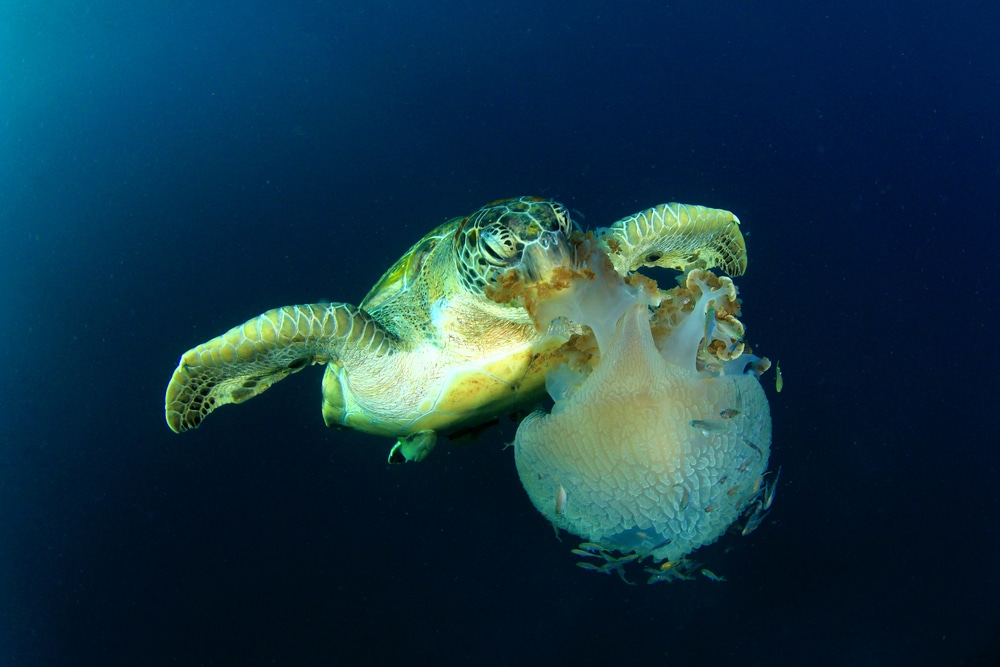
Jellyfish is the favorite food of some sea turtles. The leatherback sea turtle, in particular, loves jellyfish. Many fish eat them as well. Species include blue rockfish, dogfish, anchovies, molas, mackerel, chum salmon, ocean sunfish, grey triggerfish. They may also be eaten by some species of seabirds, whale sharks, some whales, and some crabs.
You may also like: Turtle Vs Tortoise: 7 Key Differences Detailed With Images And Facts
Can You Eat Jellyfish?

Yes, you can eat jellyfish, although it’s hard to find in most restaurants. It’s considered a luxury item, and it’s mostly available in eastern countries. It is a very popular dish across Thailand, China, and Japan.
In fact, jellyfish can be quite nutritious. They are high in protein, minerals, and antioxidants. At the same time, they are low in calories and fat.
You may also like: A Deep Dive Into The 25 Types Of Sharks (Names, Chart And Pictures)
FAQ
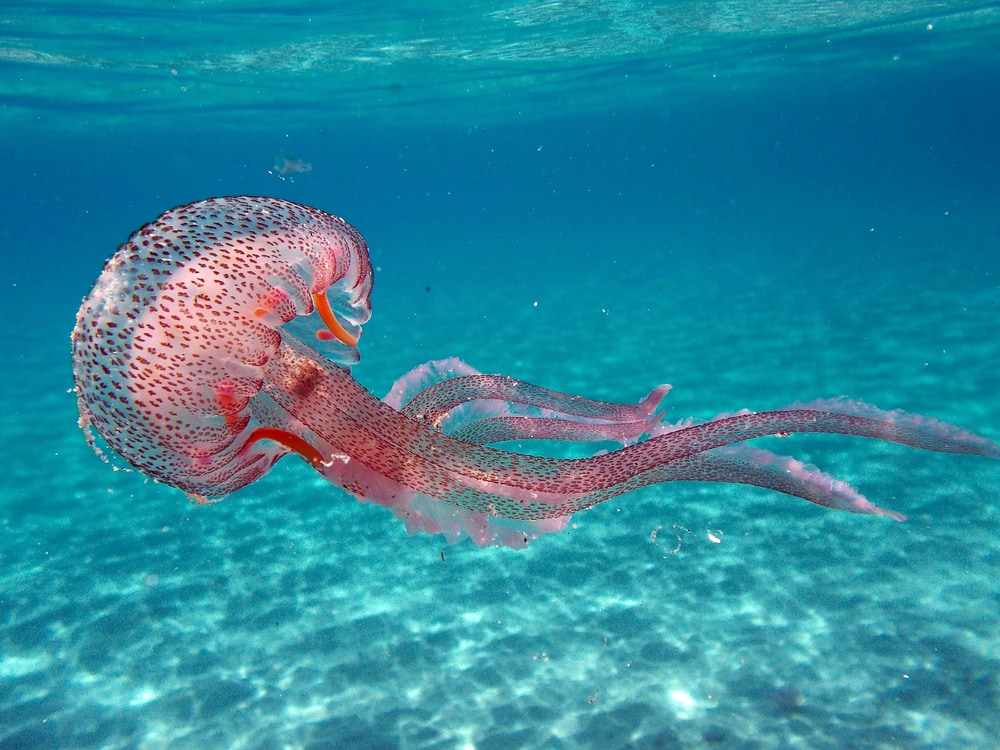
Are jellyfish carnivores?
Yes, jellyfish are carnivorous species, although some will eat phytoplankton as well. Their favorite foods include copepods, fish larvae, fish eggs, phytoplankton, planktonic eggs, and other jellyfish.
Do jellyfish have teeth?
No, jellyfish do not have teeth. Rather, they have oral arms that pull the food toward their mouth. The food is then pulled into the mouth, whole, where it digests in the stomach.
What eats jellyfish the most?
The most common predators of jellyfish are large fish. This includes blue rockfish, dogfish, anchovies, molas, mackerel, chum salmon, ocean sunfish, grey triggerfish. They are also eaten by leatherback sea turtles, some crabs, and some seabirds.
Do jellyfish like dirty water?
Jellyfish don’t necessarily “like” dirty water, but they can thrive in it. Jellyfish are much less sensitive to dirty, polluted water than other ocean creatures. So, the pollution going into the ocean isn’t really having an effect on jellyfish.
How often should you feed a jellyfish?
Did you know that you can keep jellyfish as pets? You can, and since they are not sensitive to water changes, they make a fairly easy pet to keep.
If you keep a jellyfish as a pet, you should feed it once or twice a day. The best jellyfish food is live baby brine shrimp.
More from Outforia – Check Out These Amazing Jellyfish Species
Crystal Jellyfish | Immortal Jellyfish | Fried Egg Jellyfish







